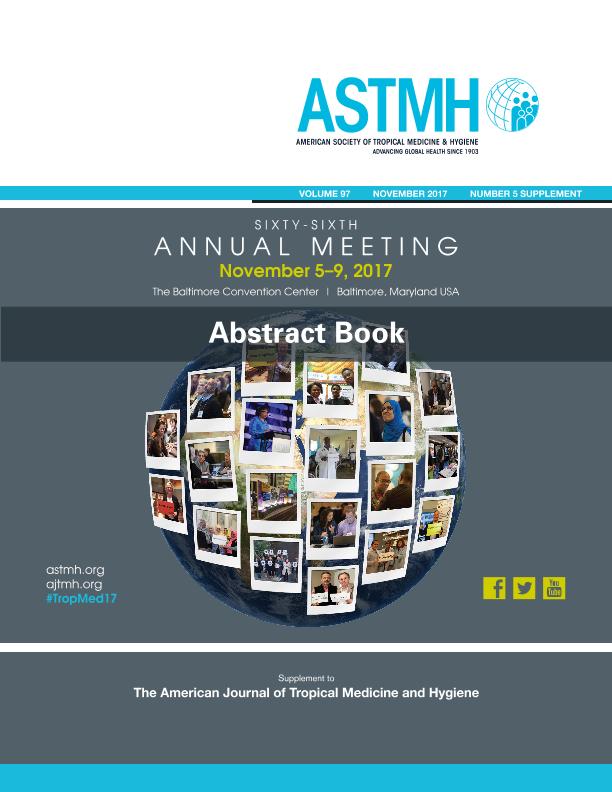Evento
Detecting albendazole metabolites in serum and urine: a first step in developing an indicator of MDA compliance in humans
Ceballos, Laura ; Cimino, Rubén Oscar
; Cimino, Rubén Oscar ; Juarez, Marisa del Valle; Moreno Torrejon, Laura
; Juarez, Marisa del Valle; Moreno Torrejon, Laura ; Banal, Juan Pablo; Alvarez, Luis Ignacio
; Banal, Juan Pablo; Alvarez, Luis Ignacio ; Krolewiecki, Alejandro Javier
; Krolewiecki, Alejandro Javier ; Walson, Judd; Lanusse, Carlos Edmundo
; Walson, Judd; Lanusse, Carlos Edmundo
 ; Cimino, Rubén Oscar
; Cimino, Rubén Oscar ; Juarez, Marisa del Valle; Moreno Torrejon, Laura
; Juarez, Marisa del Valle; Moreno Torrejon, Laura ; Banal, Juan Pablo; Alvarez, Luis Ignacio
; Banal, Juan Pablo; Alvarez, Luis Ignacio ; Krolewiecki, Alejandro Javier
; Krolewiecki, Alejandro Javier ; Walson, Judd; Lanusse, Carlos Edmundo
; Walson, Judd; Lanusse, Carlos Edmundo
Tipo del evento:
Reunión
Nombre del evento:
66° Annual Meeting of American Society of Tropical Medicine and Hygiene
Fecha del evento:
05/11/2017
Institución Organizadora:
American Society of Tropical Medicine and Hygiene;
Título del Libro:
66° Annual Meeting of American Society of Tropical Medicine and Hygiene
Título de la revista:
Revista del congreso
Editorial:
American Society of Tropical Medicine and Hygiene
Idioma:
Inglés
Clasificación temática:
Resumen
The neglected tropical diseases (NTDs) are a group of pathogens affecting individuals in the poorest regions of the world. Among them, Soil Transmitted Helminth (STH) infections directly impact nutritional status, educational development, individual productivity, and physical and mental development in human populations. Currently, these infections are controlled through mass drug administration (MDA) programs using albendazole (ABZ) or mebendazole. However, not all programs have demonstrated expected impact on prevalence or intensity of infections. These failures may be related to poor programmatic coverage, suboptimal adherence or the exposure of parasites to sub-therapeutic drug concentrations due to poor drug dissolution, insufficient gastrointestinal absorption and/or systemic availability of the active ingredient. Accordingly, improved knowledge of the basic pharmaco-kinetics of ABZ in treated people is critical. As part of the DeWorm3 project, we sought to characterize the serum disposition kinetics and pattern of urinary excretion of ABZ and its main metabolites (ABZ sulphoxide (ABZSO) and ABZ sulphone (ABZSO2)) in non-infected human volunteers. In addition, we sought to determine the duration and optimal timepoint where ABZ and/or its metabolites can be measured in urine as an indirect assessment of an individual?s adherence to treatment. Consecutive venous blood and urine samples were collected from eight (8) healthy volunteers between 2 and 72 h (serum) and 4 and 72 h (urine) for HPLC analysis of ABZ/metabolites following administration of a single postprandial oral dose of ABZ (400 mg Glaxo SmithKline).The ABZSO metabolite was the main analyte recovered either in serum and urine samples from ABZ-treated human. ABZSO serum concentrations reached its peak concentration (Cmax= 1.20 ± 0.44 μg/mL) at 4.75 h post-treatment. In urine ABZSO Cmax value was 3.24 ± 1.51 μg/mL, reached at 6.50 h post ABZ administration. The urinary AUC value, resulted higher (2.3 fold) compared to that measured in serum. The overall, PK-based information reported here demonstrates that the measurement of ABZSO concentrations both in serum and urine could be useful to confirm compliance to ABZ treatment and an objective measurement of program coverage.
Palabras clave:
ALBENDAZOLE
,
PHARMACOKINETICS
,
HUMAN
Archivos asociados
Licencia
Identificadores
Colecciones
Eventos(CCT - TANDIL)
Eventos de CTRO CIENTIFICO TECNOLOGICO CONICET - TANDIL
Eventos de CTRO CIENTIFICO TECNOLOGICO CONICET - TANDIL
Eventos(CIVETAN)
Eventos de CENTRO DE INVESTIGACION VETERINARIA DE TANDIL
Eventos de CENTRO DE INVESTIGACION VETERINARIA DE TANDIL
Citación
Detecting albendazole metabolites in serum and urine: a first step in developing an indicator of MDA compliance in humans; 66° Annual Meeting of American Society of Tropical Medicine and Hygiene; Baltimore; Estados Unidos; 2017; 166-166
Compartir



